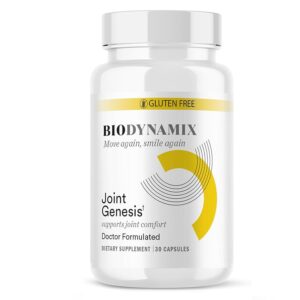Spending long hours at a desk or in front of a computer screen may not seem as physically demanding as running a marathon, but for your joints, the impact can be just as serious. Desk workers and gamers often sit for extended periods with limited movement, leading to stiffness, poor circulation, and long-term joint discomfort. Over time, the lack of mobility combined with repetitive micro-movements, such as typing or using a mouse, can increase the risk of joint pain in the neck, back, wrists, and knees.
The good news is that joint supplements can help. By providing essential nutrients that support cartilage, connective tissue, and joint lubrication, these supplements can reduce stiffness, improve mobility, and protect long-term joint health. In this guide, we’ll explore the best joint supplements for desk workers and gamers, how they work, and what to expect when taking them consistently.
Why Desk Workers and Gamers Need Joint Support
Most people think of joint supplements as being only for athletes, but anyone with a sedentary lifestyle can benefit. Here’s why:
- Prolonged sitting compresses the spine and hips – leading to back stiffness and lower-body discomfort.
- Reduced circulation – makes it harder for nutrients to reach cartilage and connective tissue.
- Repetitive strain from typing and gaming – puts pressure on finger, wrist, and elbow joints.
- Poor posture – contributes to neck and shoulder pain, which can worsen over time.
- Age factor – by the mid-30s and beyond, natural collagen and hyaluronic acid levels decline, accelerating stiffness.
Adding joint-supporting supplements to your daily routine can help counteract these issues, especially when combined with stretching, ergonomic adjustments, and regular breaks.
Top Joint Supplements for Desk Workers and Gamers
1. Glucosamine and Chondroitin
These two compounds are naturally found in cartilage and help maintain its strength and elasticity.
Benefits:
- Support cartilage repair in weight-bearing joints like knees and hips.
- Reduce stiffness from prolonged sitting.
- May slow cartilage degeneration over time.
Best for: Office workers or gamers who experience knee cracking, stiffness, or early arthritis symptoms.
2. Collagen Peptides
Collagen is the structural protein in ligaments, tendons, and connective tissue. Unfortunately, collagen production declines with age.
Benefits:
- Improves tendon and ligament resilience.
- Supports spinal discs and reduces lower back discomfort.
- Helps strengthen connective tissue in wrists and fingers, where gamers often feel strain.
Best for: Desk workers with posture-related back pain and gamers experiencing wrist strain.
3. Hyaluronic Acid
Known as the body’s natural lubricant, hyaluronic acid helps joints glide smoothly.
Benefits:
- Improves joint cushioning, especially in knees and hips.
- Reduces stiffness after sitting for hours.
- Supports overall hydration in cartilage and connective tissues.
Best for: Anyone experiencing stiffness when standing up after long desk sessions.
4. Turmeric (Curcumin)
Turmeric contains curcumin, a natural anti-inflammatory compound that helps calm irritation caused by repetitive stress.
Benefits:
- Reduces inflammation from long hours of immobility.
- Helps prevent flare-ups in wrists and shoulders.
- Supports faster recovery from overuse-related soreness.
Best for: Gamers with wrist or elbow pain, or desk workers with shoulder tension.
5. Omega-3 Fatty Acids (Fish Oil or Algal Oil)
Omega-3s are healthy fats that play a critical role in reducing inflammation throughout the body.
Benefits:
- Reduces joint swelling and stiffness.
- Improves circulation for better nutrient delivery to joints.
- Supports heart and brain health, which is an added bonus for long work or gaming sessions.
Best for: Desk workers and gamers who want both joint and overall wellness support.
6. Boswellia Serrata
This herbal extract, also known as Indian frankincense, has been shown to reduce inflammation and improve mobility.
Benefits:
- Helps decrease stiffness in the spine and hips.
- Works synergistically with turmeric for greater anti-inflammatory effects.
- May help with posture-related lower back discomfort.
Best for: Anyone with chronic stiffness from sitting too long.
7. MSM (Methylsulfonylmethane)
MSM is a sulfur-based compound that supports joint and connective tissue health.
Benefits:
- Reduces everyday stiffness and joint discomfort.
- Supports collagen formation for stronger tendons and ligaments.
- Helps maintain flexibility for long-term desk work or gaming sessions.
Best for: Desk workers and gamers who want all-around joint support.
How to Choose the Right Joint Supplement
When selecting supplements, keep these tips in mind:
- Look for combination formulas – Many of the best products combine glucosamine, collagen, hyaluronic acid, and turmeric for maximum benefits.
- Check for purity and testing – Choose supplements verified by third-party labs.
- Match to your needs – If stiffness is your main issue, hyaluronic acid may help most. If repetitive strain is the problem, collagen and MSM are better choices.
- Be consistent – Supplements work gradually, so commit for at least 8–12 weeks.
Timeline: What to Expect
- Weeks 1–2: Some users notice reduced stiffness in the morning, especially with turmeric and omega-3s.
- Weeks 3–4: Greater flexibility when standing up after long sitting periods.
- Weeks 6–8: Noticeable reduction in joint discomfort, particularly in knees, wrists, and back.
- Weeks 12+: Long-term improvements in mobility, posture comfort, and overall joint resilience.
Safety and Side Effects
Most natural supplements are safe for long-term use, but consider these precautions:
- Avoid glucosamine if allergic to shellfish.
- Consult your doctor if you take blood thinners (turmeric and omega-3s may interact).
- Choose trusted brands to avoid contaminants or fillers.
Lifestyle Tips to Maximize Joint Health for Desk Workers and Gamers
Supplements work best when paired with healthy habits:
- Take movement breaks every 30–60 minutes to reduce stiffness.
- Adjust your workstation ergonomics to keep your spine aligned.
- Use wrist supports if typing or gaming for long hours.
- Incorporate stretching and light exercise to improve blood flow.
- Stay hydrated, as dehydration worsens joint stiffness.
Final Thoughts
Desk workers and gamers may not face the same physical challenges as athletes, but their joints are still under daily stress. Sitting for long periods, repetitive hand movements, and poor posture can all accelerate joint discomfort after 40.
The best joint supplements for desk workers and gamers include glucosamine, collagen, hyaluronic acid, turmeric, omega-3 fatty acids, Boswellia, and MSM. Each offers unique benefits, from reducing stiffness and inflammation to improving cartilage strength and joint lubrication.
When combined with proper ergonomics, movement breaks, and stretching, these supplements can help keep your joints flexible, resilient, and pain-free—even after years of desk work or gaming.



